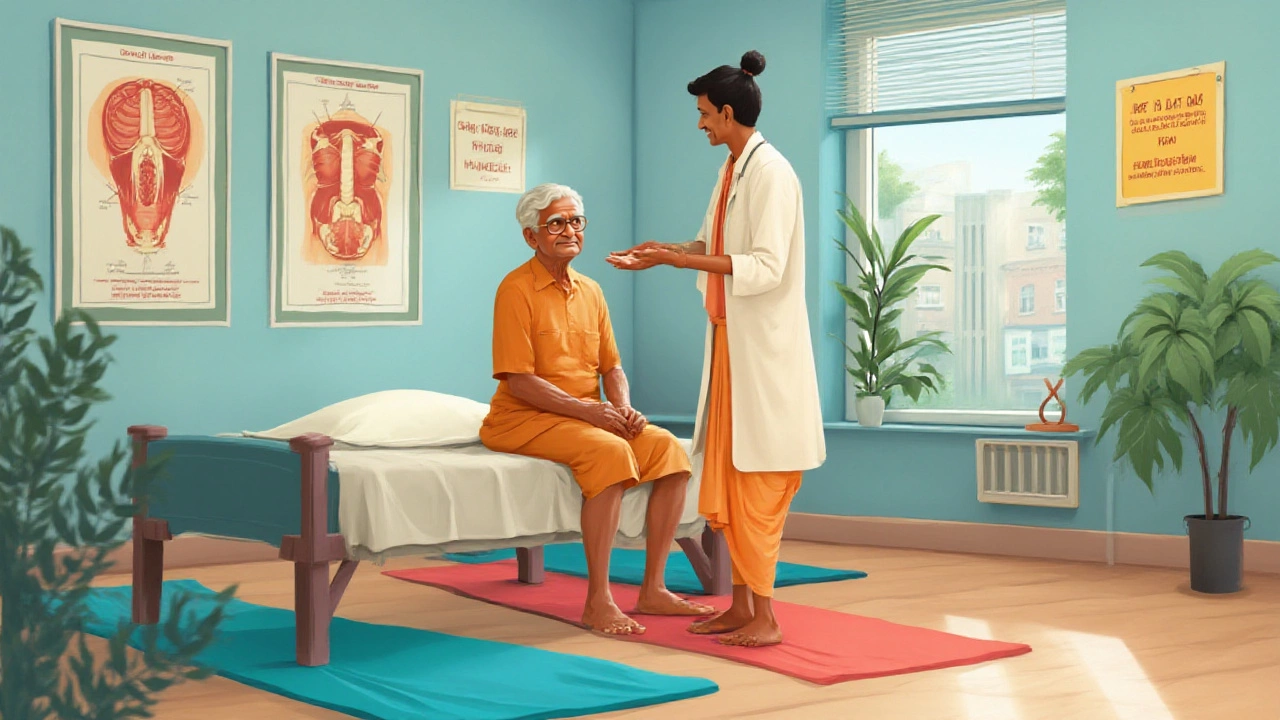It hits you out of nowhere—a sharp knee twinge as you climb the stairs, or maybe your back has that stubborn ache that's just not giving up. Most people dread the idea of seeing an orthopedic doctor, picturing sterile rooms, intimidating machinery, or hearing words like 'surgery' and 'rehab.' But guess what? Visiting an orthopedic isn’t the stuff of medical dramas; it’s a lot less scary and a lot more ordinary than you might think. Knowing the inside scoop before you book an appointment can turn that anxiety into confidence, and who wouldn’t want that?
Why You’d See an Orthopedic Doctor
Ever wondered what actually drives people into an orthopedic office? It’s not always broken bones or dramatic sports injuries. In reality, most people go because their shoulder has been nagging them, or that old ankle twist is acting up again when jogging. Orthopedic specialists focus on any pain or problem in your bones, joints, muscles, or ligaments—from head to toe. It’s not unusual for folks with lower back pain, arthritis, carpal tunnel, or even those unexplained finger cramps to turn up for a checkup.
Orthopedics is a vast field. About 1 in 2 adults in their lifetime see an orthopedic for back pain or joint stiffness. The variety is what surprises many people: kids with growing pains, office workers developing wrist pain from endless typing, athletes who want to get back into the game, and retirees dealing with creaky knees. The truth is, orthopedics isn’t just about surgery at all. It’s often about helping people avoid surgery with targeted exercises, lifestyle tweaks, or other treatments.
If you’ve struggled to walk up stairs or can’t sleep because your hip throbs, you’re not alone. Around 54 million adults in the U.S. suffer from arthritis, according to CDC stats. That’s a huge reason why orthopedic clinics tend to be busy places, filled with all ages and fitness levels. Even weekend warriors who overdo it mowing the lawn or ambitious gardeners with sore wrists line up for advice.
People often wait too long, thinking pain will vanish on its own, but early intervention can make a world of difference. You don’t have to be a star athlete or have a dramatic injury to benefit from an orthopedic visit—if life’s small injuries are adding up, or pain is sucking the fun out of things you love, this is the right place to get answers.
Your First Visit: What Really Happens Behind the Door
The unknown is what makes people nervous, right? The first step at an orthopedic is rarely what you see on TV—emergency surgeries or a team in scrubs sprinting around. Usually, you’ll check in, fill out a few forms about your symptoms, medical history, and daily habits, then you wait in an ordinary room with posters showing skeletons or muscle systems. Most clinics have a calm, friendly vibe.
The doctor (and sometimes a nurse or PA first) will ask: Where does it hurt? When did it start? What makes it worse? If you play sports or do repetitive work activities, it’s good to be honest, even about those embarrassing weekend fails. Expect a hands-on exam—they’ll gently move your joints, check your range of motion, ask you to walk, squat, or maybe stand on one leg. It’s less about pain and more about figuring out what your body can and can’t do comfortably.
Orthopedists use clues from your movement, swelling, or tenderness to build a puzzle. They’ll also look for things like bruising, how a joint lines up, or any popping, clicking, or locking. Don’t worry if you can’t remember every detail of your injury, but specifics really help—did your knee pop when you ran? Does your wrist ache more after typing?
If your case is straightforward, the diagnosis might happen on the spot. Other times, the doctor might order extra tests. This isn’t because they’re unsure, but to truly rule out anything serious or double-check what’s going on inside a joint. By the end, you’ll leave with a clear idea of what’s happening, plus next steps—and it probably won’t include any scary talk of surgery unless it’s absolutely necessary.

Common Diagnostic Tools and Tests
If you’ve ever googled “what happens when you go to an orthopedic,” you might imagine a battery of intimidating machines. But don’t sweat it. The main tools aren’t futuristic gadgets—they’re pretty basic, but super useful. X-rays are the big one: they quickly show fractures, worn-down joints, or out-of-place bones. The process is painless and fast—think of it as getting a photo snapped, but of your bones instead of your smile.
MRI scans are a little more advanced, used for more complex stuff like torn ligaments or cartilage issues (think meniscus tears in the knee). It’s like climbing into a big, donut-shaped machine for a detailed look at soft tissues. The most uncomfortable part? You might have to keep still for 20 minutes or so, which is more boring than it is scary.
For nerve pain or numbness—like carpal tunnel—your orthopedic might do a nerve conduction study. Tiny, sticky electrodes track how signals travel along nerves. Again, no pain; just some odd tingling sensations. Sometimes, blood tests help if there’s a suspicion of arthritis or infection lurking in a joint.
All these tests serve a single goal: pinpoint the problem. No test is done just for the sake of it. Many times, the answer is already clear from your history and physical exam, and extra tests just confirm the plan. It never hurts to ask the doctor what each test checks for, or if it’s truly necessary. Getting a peek at your own x-ray can actually be pretty fascinating—you’ll literally see inside your own joints.
Treatment: Not Just Surgery
Mention orthopedics, and everyone jumps to surgery. The reality? About 80% of orthopedic visits don’t end up in the operating room. The bread and butter of treatment is much less dramatic, focusing mostly on getting you moving pain-free and safely.
Your doctor might give you a personalized set of stretches or strengthening exercises—sometimes demonstrated right there in the office. Physical therapy is a huge part of modern orthopedic care. Therapists help you build up muscles, improve balance, and even learn better movement patterns to avoid future injury. You’ll likely skip surgery if you stick with these programs (there are lots of success stories to prove it).
Other times, braces, splints, or supports come into play. Have a sprained ankle or busted finger? You’ll probably go home sporting a fancy boot or tape job. Medication is another tool. But, instead of tossing painkillers at you, most orthopedists aim for the lowest effective dose, for the shortest time. Over-the-counter NSAIDs (like ibuprofen) or specialized topical gels can do the trick in many cases, and they usually give advice to avoid long-term pill-popping.
Steroid injections sound intense, but they’re quick and can help settle stubborn swelling in joints like the knee, shoulder, or lower back. These aren’t miracle fixes, but they can break the pain-spasm cycle and get you back to moving. For chronic conditions like arthritis, lifestyle advice—like losing a few pounds, adjusting your workout, or using ergonomic gear—can make all the difference.
When surgery is truly necessary (like fixing a torn ACL or replacing worn-out hips), modern techniques are less invasive and recovery is much faster than in the old days. Surgeons might use cameras and tiny tools instead of big cuts, which means less scarring and a quicker bounce-back. Don’t be afraid to ask about second opinions or all your options—good orthopedists are used to these conversations and value your comfort as much as your healing.

Tips for a Better Orthopedic Experience
Let’s be honest—sometimes doctor visits feel like a blur. Want to get the best care when you visit an orthopedic specialist? Plan ahead, and don’t be shy. Here are some tips that can make a real difference:
- Write down your main symptoms—when they started, what makes them better/worse, and how bad they get.
- Bring a list of all medications and supplements you’re taking. You’d be surprised how often this uncovers links between pain and daily habits.
- Wear comfortable clothes, something easy to roll up or adjust, especially if the doctor needs to check your knees, hips, or shoulders.
- Bring old imaging or medical records if you’ve had treatment elsewhere—it saves time and helps avoid repeating tests.
- Don’t be afraid to ask questions. Want to know what the orthopedic doctor is looking for on an MRI? Curious about all possible non-surgical treatments? Just ask!
- If you’re given exercises, stick to them! Recovery is 90% what you do outside the doctor’s office.
- Set realistic goals and don’t push too hard too soon. Healing is a process, not a sprint.
Staying open and honest with your orthopedic doctor helps build trust—and leads to a plan tailored just for you. And remember, you’re not on your own. Orthopedic care is about teamwork: the doctor, physical therapist, nurses, and you, all working together.
If you dread the idea of going to the orthopedics, just know this: You’re taking control of your health. Whether it’s learning that a stiff knee doesn’t mean you need surgery, or finally getting real advice on safely playing basketball after 40, it can totally shift your perspective. That first step into the office? It could be the best move for your comfort, mobility, and future fun—no drama required.
